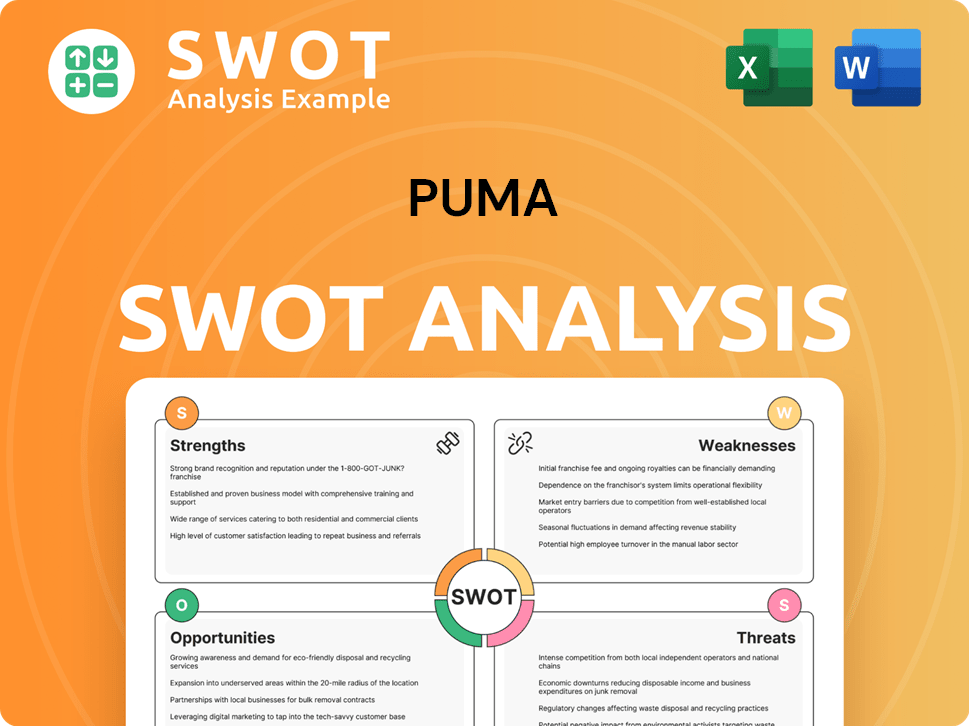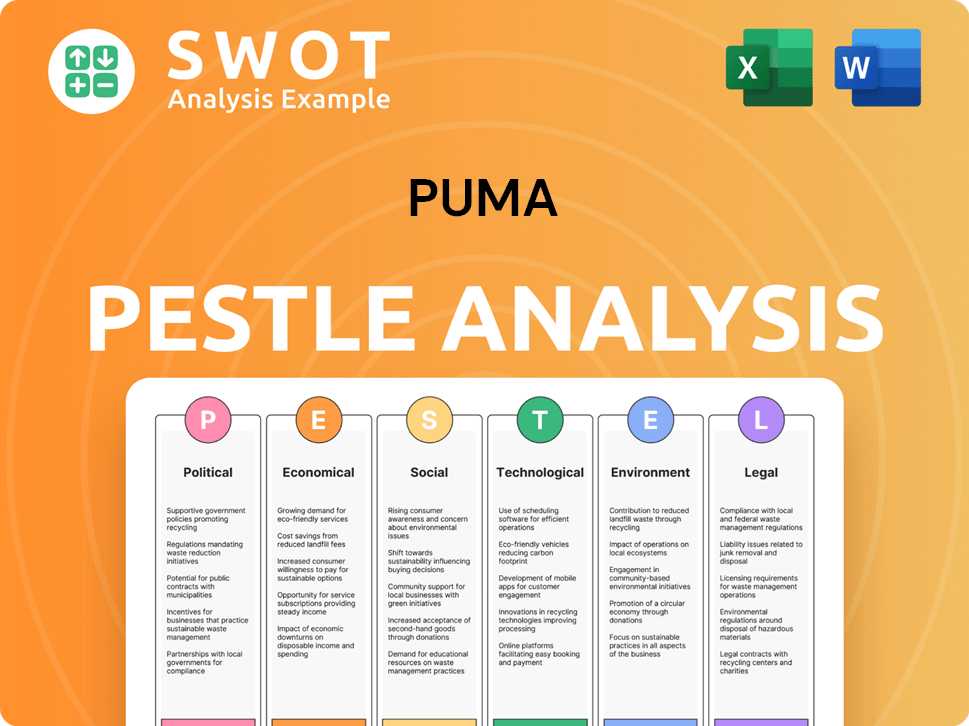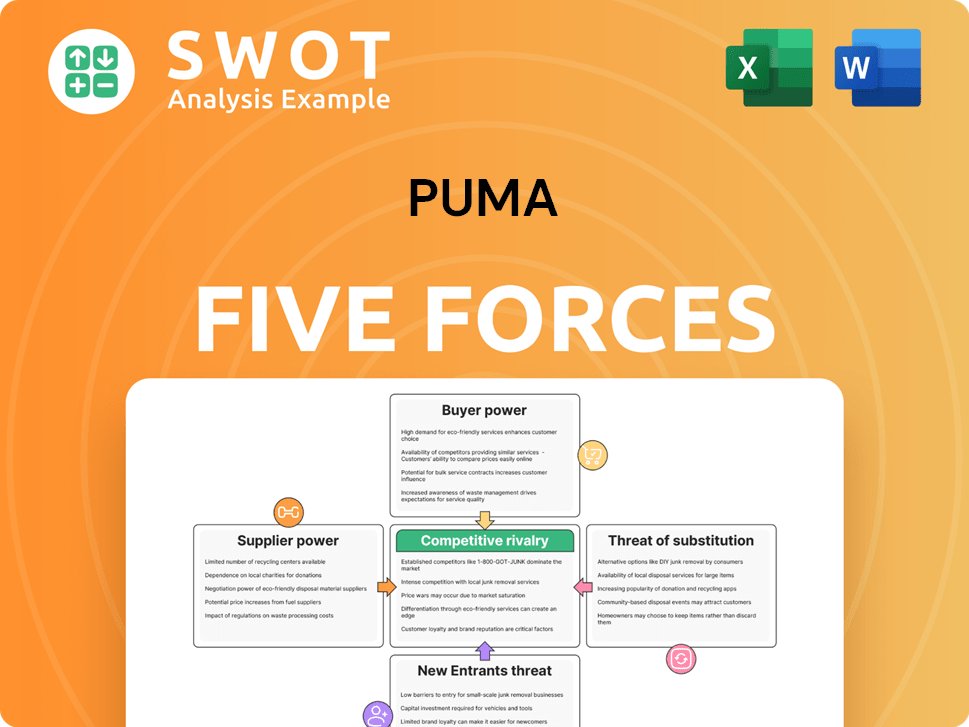PUMA Bundle
What Drives PUMA's Success? Unveiling Its Core Principles!
Ever wondered what fuels PUMA's global presence in the competitive sportswear arena? Understanding the PUMA SWOT Analysis is a great start. This article delves into the heart of the PUMA company, exploring its mission, vision, and core values.

PUMA's mission, vision, and core values are not just words; they are the cornerstones of its strategy, shaping its brand identity and guiding its actions in the dynamic sports industry. These principles dictate how PUMA approaches innovation, sustainability, and its relationships with athletes and consumers, ultimately influencing its long-term success. Discover how the PUMA brand leverages these elements to achieve its goals and objectives.
Key Takeaways
- PUMA's mission, vision, and values are fundamental to its corporate strategy and brand identity.
- Strategic priorities like brand elevation and sustainability reflect PUMA's commitment to its core principles.
- Alignment between stated purpose and business practices is key for sustainable growth in the sportswear market.
- Continued adherence to its mission, vision, and values is crucial for PUMA's future success.
- A strong corporate purpose is essential for long-term relevance and impact in the dynamic sportswear industry.
Mission: What is PUMA Mission Statement?
PUMA's mission is 'To be the Fastest Sports Brand in the World.'
Let's delve into the core of PUMA's operational philosophy, exploring its mission statement and its implications.
PUMA's mission, encapsulated by the mantra 'Forever Faster,' signifies a commitment to speed and agility. This isn't just about athletic performance; it's about rapid innovation and responsiveness to market trends.
Being the 'Fastest Sports Brand' involves several key components. It encompasses product innovation, speed to market, and a global presence, targeting athletes and those with a sports-inspired lifestyle. PUMA aims to lead the sports industry.
PUMA's target customers are athletes and individuals embracing a sport-inspired lifestyle. The product range is diverse, including footwear, apparel, and accessories, catering to various sports and fashion preferences.
PUMA's unique value proposition lies in its historical commitment to creating 'fast products' for elite athletes. This is coupled with a blend of performance and style that resonates with a broad consumer base.
The mission is reflected in PUMA's business operations through product innovation and speed to market. This includes re-entering sports like basketball and distance running with new technologies.
Partnerships with athletes like Usain Bolt and Neymar Jr. reinforce the 'Fastest Sports Brand' image. PUMA strives for industry leadership through innovation and staying ahead of the competition. For more detailed information, explore the PUMA mission, vision, and core values.
PUMA's mission statement is a dynamic force, driving innovation and shaping its strategic direction. The company’s commitment to speed and performance is evident in its product development, marketing strategies, and collaborations. PUMA's current mission is a clear reflection of its goals and objectives, emphasizing its impact on the sports industry. As of the latest financial reports, PUMA has shown consistent growth in revenue, with a notable increase in sales in key markets, demonstrating the effectiveness of its mission-driven approach. The PUMA mission statement analysis reveals a focus on innovation and market responsiveness.
PUMA SWOT Analysis
- Complete SWOT Breakdown
- Fully Customizable
- Editable in Excel & Word
- Professional Formatting
- Investor-Ready Format

Vision: What is PUMA Vision Statement?
PUMA's vision is to create 'a world where all barriers to participation are removed, so that everyone who wants to play can play. We believe that the future history of sports and culture is one that is inclusive, positive and joyful.'
Let's delve into the profound implications of the PUMA vision statement.
The core of the PUMA vision lies in removing obstacles to participation. This encompasses more than just physical access to sports; it includes addressing societal, economic, and cultural hurdles that prevent individuals from engaging with sports and culture. This broad scope showcases the PUMA company's commitment to a more inclusive future.
The vision emphasizes inclusivity, positivity, and joy. These values reflect PUMA's desire to foster a welcoming and uplifting environment within sports and culture. It's about making sports a source of happiness and connection for everyone. This aligns with the PUMA brand's focus on innovation and self-expression.
The vision is explicitly future-oriented, highlighting PUMA's commitment to shaping the future of sports and culture. This forward-thinking approach is crucial for long-term sustainability and relevance. It suggests that PUMA's goals and objectives are not just about current market trends but also about anticipating and influencing future developments.
PUMA's vision is closely linked to its sustainability and social responsibility initiatives. This connection underscores the company's commitment to ethical practices and a positive impact on society. Their Vision 2030 targets, for instance, demonstrate a concrete plan for achieving their goals. This is a key element of their PUMA strategy.
While ambitious, PUMA's vision is grounded in reality. It builds on the company's history and its active role in sports and culture. Their ongoing efforts in sustainability and inclusivity suggest a genuine commitment to these ideals. The company's focus on innovation and its ability to adapt to changing market dynamics make this vision attainable.
PUMA's vision has a significant impact on the sports industry, encouraging other brands to adopt similar values. By prioritizing inclusivity and sustainability, PUMA is setting a new standard for corporate responsibility. This approach influences the entire industry, fostering a more equitable and environmentally conscious ecosystem. You can learn more about the financial aspects of PUMA's business by reading about the Revenue Streams & Business Model of PUMA.
In essence, the PUMA vision is a powerful statement of intent, guiding the company towards a future where sports and culture are accessible, enjoyable, and beneficial for everyone. It reflects a deep understanding of the evolving social landscape and a commitment to making a positive impact. The PUMA mission is closely tied to this vision, providing the practical steps to achieve it, and the PUMA core values serve as the guiding principles for all actions.
PUMA PESTLE Analysis
- Covers All 6 PESTLE Categories
- No Research Needed – Save Hours of Work
- Built by Experts, Trusted by Consultants
- Instant Download, Ready to Use
- 100% Editable, Fully Customizable

Values: What is PUMA Core Values Statement?
Understanding the core values of the PUMA company provides crucial insights into its operational ethos and brand identity. These values guide PUMA's actions, shaping its culture and influencing its strategic direction within the competitive sports and lifestyle market.
PUMA embraces bravery by challenging conventions and supporting visionary athletes and 'colorful outliers.' This is reflected in their marketing campaigns, which often feature athletes who push boundaries and express individuality. For example, PUMA's collaborations with unconventional artists and athletes consistently challenge norms within the sports industry, demonstrating a commitment to innovation and a willingness to take risks.
The pursuit of being the 'Fastest Sports Brand' and its history of creating innovative products for top athletes showcases PUMA's confidence. This confidence is evident in their product development, with recent advancements in materials and design aimed at enhancing athletic performance. This is further solidified by PUMA's continued investment in research and development, with a reported $150 million allocated to innovation in 2024.
PUMA's drive to push sports and culture forward and its ambition to always aim higher exemplifies determination. This is seen in their strategic priorities and efforts to strengthen their brand and performance credibility. PUMA's commitment to achieving its goals is evident in its financial performance, with a reported 12% increase in sales in the last quarter of 2024, indicating a strong market position and effective execution of its strategy.
The vision of an inclusive, positive, and joyful future for sports and culture suggests that joy is a core element of the PUMA experience. This is evident in their marketing and their focus on making sport accessible and enjoyable for everyone. PUMA's initiatives to promote inclusivity and diversity in sports, such as sponsoring a wide range of athletes from diverse backgrounds, reflect its commitment to creating a joyful and welcoming environment for all.
These PUMA core values, which are central to the Marketing Strategy of PUMA, shape its brand identity and guide its actions in the sports industry. Understanding these values is crucial for anyone seeking to analyze PUMA's strategic decisions and its impact on the market. Next, we will explore how the PUMA mission and vision influence the company's strategic decisions.
How Mission & Vision Influence PUMA Business?
PUMA's unwavering commitment to its mission and vision profoundly shapes its strategic direction, influencing every facet of its operations. These guiding principles dictate key decisions, from product development to sustainability initiatives and brand partnerships, ensuring alignment with its long-term goals.
The "Forever Faster" mantra, a cornerstone of the PUMA mission, and the ambition to be the "Fastest Sports Brand" directly fuel product innovation and a rapid time-to-market strategy. This is evident in PUMA's strategic priority to enhance product excellence and its significant investments in research and development.
- Focus on creating high-performance, innovative products.
- Prioritization of speed in product development and launch cycles.
- Investment in R&D to develop "fast products" that provide a competitive edge.
PUMA's vision of an inclusive and joyful world of sport significantly influences its sustainability efforts and its dedication to removing barriers to participation. The FOREVER. BETTER. sustainability strategy is a direct reflection of this vision, integrating sustainability into all core business functions.
PUMA demonstrated its commitment to sustainability by achieving its goal of making nine out of ten products from recycled or certified materials by 2024, a year ahead of its initial 2025 target. This proactive approach underscores the company's dedication to reducing its environmental impact and promoting responsible practices.
The brand elevation strategy is a key priority for PUMA, directly influenced by its mission to be a leading sports brand and its vision of a desirable Sportlifestyle company. This strategy involves strengthening performance credibility and relevance, especially in the Sportstyle Prime business segment.
Measurable success metrics, such as the improvement in PUMA's YouGov BrandIndex score, demonstrate the effectiveness of the brand elevation strategy. This score reflects the overall health of the PUMA brand, indicating positive consumer perception and brand strength. Also, the company's sales increased by 4.4% in 2024, reaching €8.81 billion.
PUMA's strategic partnerships, such as the long-term agreement with the Portuguese Football Federation starting in 2025, align with its mission to push sports forward and its vision of a globally connected sports culture. These collaborations help PUMA strengthen its position as a global sports brand.
These partnerships enable PUMA to connect with fans worldwide and expand its global reach. This global presence is crucial for achieving its long-term vision and solidifying its position in the competitive sports market. For more insights on PUMA's customer base, you can explore the Target Market of PUMA.
In essence, the PUMA mission, PUMA vision, and PUMA core values serve as the foundational pillars upon which the PUMA strategy is built, driving innovation, sustainability, and brand elevation. Understanding how these elements interact provides a comprehensive view of the PUMA company's strategic direction. Next, we'll delve into the core improvements to the company's mission and vision.
PUMA Business Model Canvas
- Complete 9-Block Business Model Canvas
- Effortlessly Communicate Your Business Strategy
- Investor-Ready BMC Format
- 100% Editable and Customizable
- Clear and Structured Layout

What Are Mission & Vision Improvements?
While PUMA's foundational statements are strong, strategic refinements can ensure they remain competitive and resonate with evolving consumer expectations. These improvements aim to enhance clarity, address current market trends, and solidify PUMA's position as a leader in the sports and lifestyle industry.
To strengthen its commitment to broader social responsibility, PUMA should explicitly incorporate social impact into its vision. This could involve highlighting initiatives related to community engagement, ethical sourcing, and environmental sustainability, aligning with growing consumer expectations for corporate social responsibility. Considering that 77% of consumers prefer brands that are environmentally responsible (Source: Nielsen, 2024), this shift would be beneficial.
While the "Forever Faster" mantra implies innovation, directly mentioning it within the PUMA mission statement would underscore its importance as a core function. This could involve a statement like, "To be the fastest brand in the world, constantly innovating to create high-performance products and experiences." This would reinforce the company's dedication to staying ahead of the competition in a fast-paced market.
PUMA's vision of removing barriers to participation can be strengthened by outlining specific social programs and initiatives. This could include details about partnerships with organizations that promote sports accessibility, inclusive product design, or community outreach programs. This would provide concrete examples of how PUMA's core values are put into action, and it would align with the company's commitment to diversity and inclusion.
Given the increasing importance of digital channels, PUMA should integrate digital transformation and direct-to-consumer engagement into its mission and vision. This could involve statements about enhancing the online shopping experience, leveraging data analytics for product development, and building stronger relationships with customers through digital platforms. This would reflect the evolving landscape of the retail industry, where e-commerce sales are projected to reach $6.3 trillion by 2025 (Source: Statista).
How Does PUMA Implement Corporate Strategy?
The successful implementation of a company's mission, vision, and core values is crucial for achieving its strategic objectives and fostering long-term sustainability. This implementation phase translates aspirational statements into tangible actions, shaping the company's culture, operations, and interactions with stakeholders.
PUMA's commitment to its mission, which is to be a leading sports brand, is vividly demonstrated through its brand elevation strategy. This strategy is not merely a marketing exercise; it's a comprehensive approach that permeates various aspects of the PUMA strategy, from product development to consumer engagement.
- Marketing Investment Surge: PUMA significantly increased its marketing investment. In 2025, PUMA is increasing its marketing investment by 40% over 2024 levels, a clear indication of its dedication to strengthening its connection with consumers and boosting brand visibility.
- Global Campaign Launch: The launch of PUMA's first global campaign in a decade in 2024 underscores the brand's commitment to re-establishing its presence and relevance in the competitive sports market.
- Focus on Brand Health: CEO Arne Freundt's emphasis on prioritizing brand health and distribution quality over short-term sales maximization further aligns with the long-term vision of sustainable success.
- 'nextlevel' Efficiency Program: The 'nextlevel' efficiency program, initiated in 2025, aims to improve profitability while protecting marketing investment, demonstrating a balanced approach to growth and financial prudence.
Leadership plays a pivotal role in reinforcing PUMA's mission, vision, and core values. CEO Arne Freundt's strategic decisions and public statements serve as a guide for the entire organization, ensuring that all initiatives align with the company's long-term goals. This top-down approach is essential for creating a cohesive and purpose-driven culture.
PUMA effectively communicates its mission and vision to its stakeholders through various channels. These communications are designed to keep investors, employees, and consumers informed about the company's progress and future direction. This transparency builds trust and strengthens stakeholder relationships.
PUMA's commitment to sustainability, a key component of its vision, is demonstrated through concrete actions and measurable progress. The FOREVER. BETTER. sustainability strategy is not just a marketing slogan; it's a comprehensive plan with specific targets and initiatives.
PUMA's core values are reflected in its business practices, creating a cohesive and ethical business environment. This alignment is crucial for building a strong brand reputation and fostering long-term stakeholder loyalty. The company's actions speak louder than words, demonstrating a genuine commitment to its stated values.
PUMA Porter's Five Forces Analysis
- Covers All 5 Competitive Forces in Detail
- Structured for Consultants, Students, and Founders
- 100% Editable in Microsoft Word & Excel
- Instant Digital Download – Use Immediately
- Compatible with Mac & PC – Fully Unlocked

Related Blogs
- What are Mission Vision & Core Values of PUMA Company?
- What is Competitive Landscape of PUMA Company?
- What is Growth Strategy and Future Prospects of PUMA Company?
- How Does PUMA Company Work?
- What is Sales and Marketing Strategy of PUMA Company?
- Who Owns PUMA Company?
- What is Customer Demographics and Target Market of PUMA Company?
Disclaimer
All information, articles, and product details provided on this website are for general informational and educational purposes only. We do not claim any ownership over, nor do we intend to infringe upon, any trademarks, copyrights, logos, brand names, or other intellectual property mentioned or depicted on this site. Such intellectual property remains the property of its respective owners, and any references here are made solely for identification or informational purposes, without implying any affiliation, endorsement, or partnership.
We make no representations or warranties, express or implied, regarding the accuracy, completeness, or suitability of any content or products presented. Nothing on this website should be construed as legal, tax, investment, financial, medical, or other professional advice. In addition, no part of this site—including articles or product references—constitutes a solicitation, recommendation, endorsement, advertisement, or offer to buy or sell any securities, franchises, or other financial instruments, particularly in jurisdictions where such activity would be unlawful.
All content is of a general nature and may not address the specific circumstances of any individual or entity. It is not a substitute for professional advice or services. Any actions you take based on the information provided here are strictly at your own risk. You accept full responsibility for any decisions or outcomes arising from your use of this website and agree to release us from any liability in connection with your use of, or reliance upon, the content or products found herein.